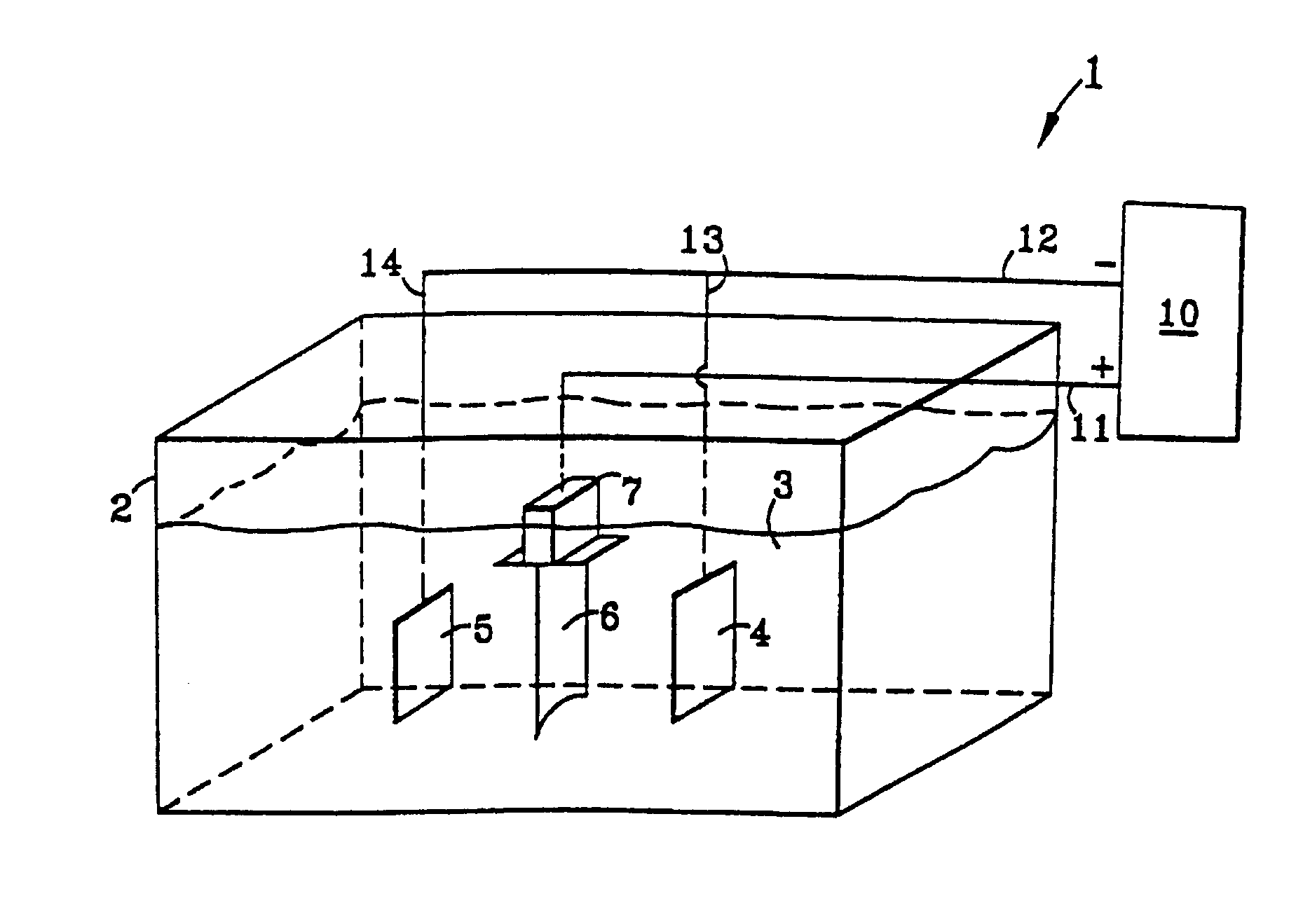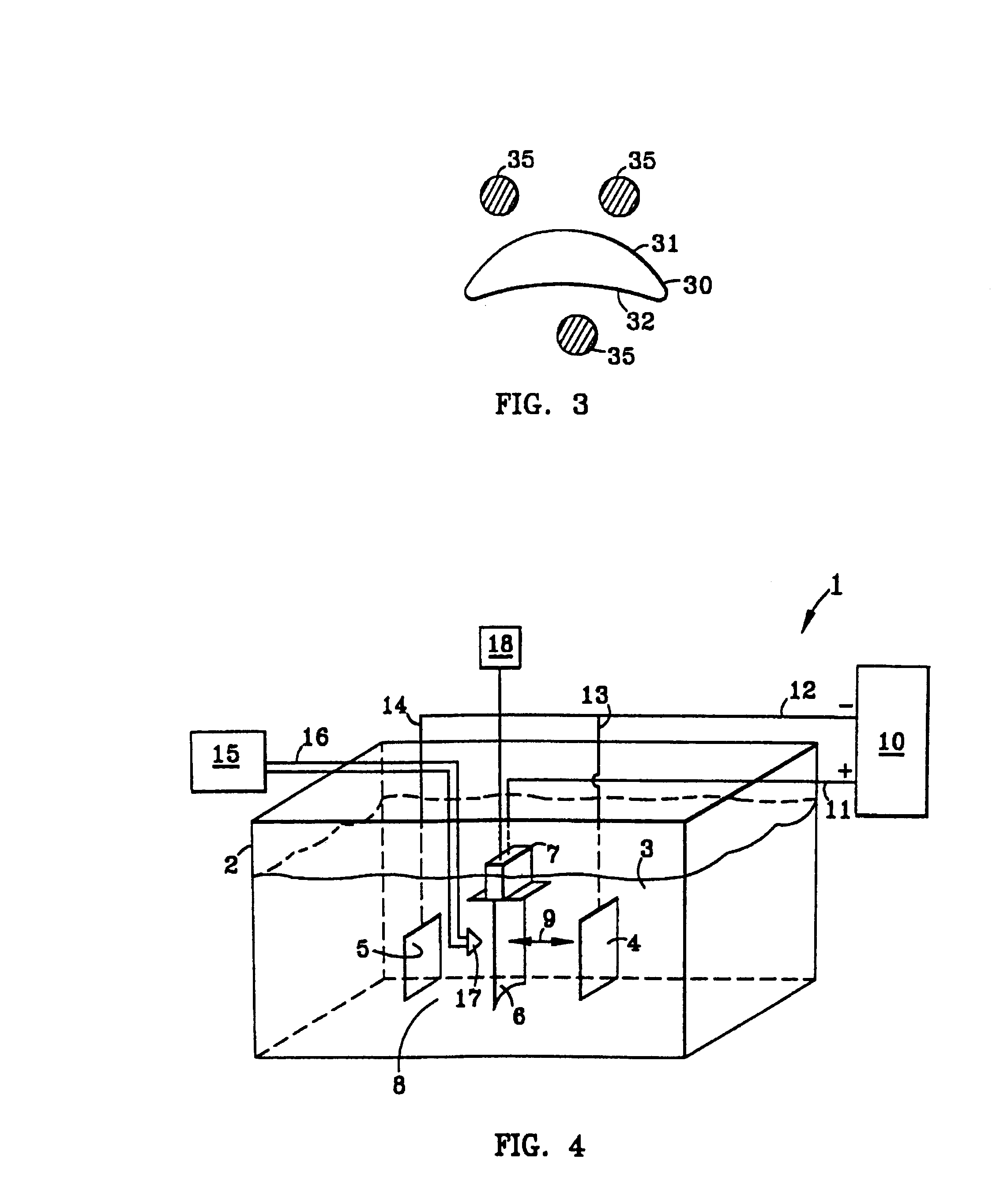Method and apparatus for selectively removing coatings from substrates
a substrate and coating technology, applied in the field of electrochemical methods, can solve the problems of not always including the features needed in specialized situations, undesirable loss of substrate material, change in critical dimensions, etc., and achieve the effect of reducing the thickness of the substra
- Summary
- Abstract
- Description
- Claims
- Application Information
AI Technical Summary
Benefits of technology
Problems solved by technology
Method used
Image
Examples
example 1a
coupon formed from a nickel-base superalloy was used in this example.
A platinum layer having a thickness of about 5 microns was electroplated onto the superalloy surface. The coated surface was then diffusion-aluminided to a depth of about 75 microns. The coupon was then heat-treated at 2050F (1121C) for 47 hours, in order to simulate a service environment. The coated coupon was then treated according to an embodiment of this invention, to determine the effect of the treatment over a preselected time period.
Treatment was carried out by using an electrochemical stripping system similar to that depicted in FIG. 1. The distance from the cathode to the anode in the stripping apparatus was about 1 inch (2.54 cm). 10% H.sub.2 SiF.sub.6 (by weight) in water was used as the electrolyte. The stripping bath was maintained at room temperature. A voltage (cell potential) of 1.1 volts with a pulsed wave form of 400 msec "on" and 10 msec "off" was applied to the electrochemical cell.
FIG. 11 is a ...
example 3a
turbine blade similar to that of Example 2 was exposed to the same electrochemical process. However, the exposure time (i.e., immersion time in the treatment solution) was 90 minutes. The blade sections taken at the 80% span section for the leading edge, pressure side, and suction side of the blade are depicted in micrographs D, E and F of FIG. 13.
It is clear from FIG. 13 that after 90 minutes of exposure, the aluminide coating was completely removed. Moreover, the base metal did not show any sign of material loss. Furthermore, the coating material on the interior hole in the leading edge section was not removed. This is an important attribute because it demonstrates that internal masking of the hole is not required when the present process is followed. This attribute extends to any internal region or cavity in an article, e.g., indentations, hollow regions, or holes. In the case of a turbine airfoil, the internal region is often in the form of radial cooling holes or serpentine pas...
example 4a
coupon of a nickel-based superalloy was coated with a platinum-aluminide diffusion coating, to an overall thickness of about 75 microns. The coated coupon was heat-treated at 2075F (1135C) for about 47 hours, to simulate an engine-run coating. The coupon was divided into five sections, each individually masked. Each section was exposed to the electrochemical stripping process for different time periods, by removing a selected mask at a different exposure time. An electrical cell potential of 1.1 V was used in the stripping bath, with a pulsed wave form of 400 ms "on" and 10 ms "off". The cathode was a flat copper screen held 1 inch (2.54 cm) away from the coupon. The electrolyte was a 10% solution of H.sub.2 SiF.sub.6 in water.
Micrographs from each of the coupon sections are depicted in FIG. 14. As described above, this type of diffusion coating includes an additive sublayer and a diffusion sublayer (regions "A" and "B", respectively, in the "0 min" micrograph of FIG. 14). The addit...
PUM
| Property | Measurement | Unit |
|---|---|---|
| time period | aaaaa | aaaaa |
| time period | aaaaa | aaaaa |
| thickness | aaaaa | aaaaa |
Abstract
Description
Claims
Application Information
 Login to View More
Login to View More - R&D
- Intellectual Property
- Life Sciences
- Materials
- Tech Scout
- Unparalleled Data Quality
- Higher Quality Content
- 60% Fewer Hallucinations
Browse by: Latest US Patents, China's latest patents, Technical Efficacy Thesaurus, Application Domain, Technology Topic, Popular Technical Reports.
© 2025 PatSnap. All rights reserved.Legal|Privacy policy|Modern Slavery Act Transparency Statement|Sitemap|About US| Contact US: help@patsnap.com



